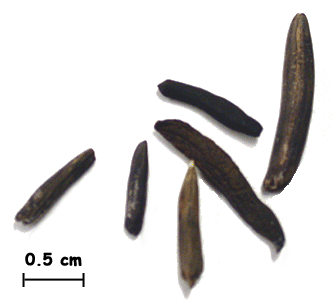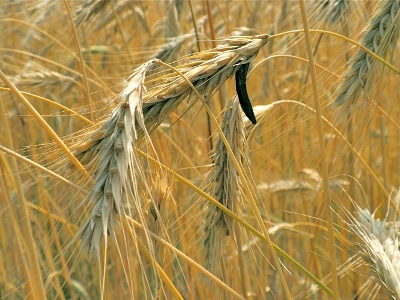Living the Good Life! (Adaptation)
HOW HAS THIS ORGANISM ADAPTED TO ITS HABITAT?
 Fungi have had to adapt in many ways because they can't make
their own food like plants by photosynthesis or move to acquire
food. In order to overcome this, fungi have a
structure called hyphae, which they use to break down and absorb
nutrients with exoenzymes. Claviceps purpurea is further adapted
to live in its habitat because it infiltrates the vascular
tissue of its hosts to get its nutrition. By not killing the
host, ergot ensures that it will always have a constant food
supply another very important adaptation. What a lazy "fun-guy"!
Distributing spores is also somewhat of a difficulty when you're
immotile, so it produces honeydew to overcome this problem. The honeydew is a sticky substance
filled with conidia that can either be
splashed to other plants by rain drops or transported by an insect vector.
When an insect, like a
bumble bee, lands on the
plant and then flies to another plant, the spores can be
transmitted and another plant can become infected.
Fungi have had to adapt in many ways because they can't make
their own food like plants by photosynthesis or move to acquire
food. In order to overcome this, fungi have a
structure called hyphae, which they use to break down and absorb
nutrients with exoenzymes. Claviceps purpurea is further adapted
to live in its habitat because it infiltrates the vascular
tissue of its hosts to get its nutrition. By not killing the
host, ergot ensures that it will always have a constant food
supply another very important adaptation. What a lazy "fun-guy"!
Distributing spores is also somewhat of a difficulty when you're
immotile, so it produces honeydew to overcome this problem. The honeydew is a sticky substance
filled with conidia that can either be
splashed to other plants by rain drops or transported by an insect vector.
When an insect, like a
bumble bee, lands on the
plant and then flies to another plant, the spores can be
transmitted and another plant can become infected.
HOW DOES ERGOT RESPOND TO ENVIRONMENTAL STIMULI?
In my research, I didn't find too many ways that Claviceps purpurea
responds to the environment, but I did find that oxygen is very
beneficial for mycelium growth. That's about it for this fungus! It
does respond to environmental conditions by forming the hardened
sclerotium to survive the winter, but that is just a part of the
lifecycle and I couldn't find a specific environmental stimuli
that causes it.
HOW IS STRUCTURE RELATED TO FUNCTION?
As in all of biology, the structure of something is always closely
related to its function. To begin, as I said above, ergot forms
hardened sclerotium to help it survive through the winter months.
The structure, the hardened shell, is very much related to the
function of staying alive in this case. Also, the sticky honeydew's
function is to adhere to other organisms and spread the spores from
plant to plant. Obviously, the structure of the honeydew is closely
related to its function of spore dispersal. The hyphae
structure is also closely related to function because its use is to
infiltrate the plant, break down components and sequester nutrients. This structure
utilizes exoenzymes to break down the plant components until it
reaches the vascular tissue where it then absorbs its nutrients.
Can't wait to learn more? Then go on to the INTERACTIONS page! Otherwise, head back HOME.